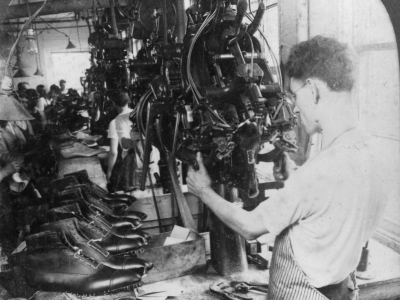
On May 29, 1885, self-tought inventor Jan Ernst Matzeliger conducted the first public demonstration of his shoe-lasting machine. By automating a stage of shoe production that everyone thought was impossible to do, Matezliger forever change the shoe manufacturing industry.
Do you know what the term “lasting” means in the shoe industry? Lasting corresponds to the operation of stretching the shoe upper over the foot form or “last”. There are many ways in which these lasting operations are performed and almost all shoes in today’s world are lasted in some way.
For the longest time it was believed that lasting could not be automated. Even as the rest of the shoe-making process was mechanised, hand lasters held a special place in the footwear factory as they continued to pull uppers over and nail them onto the lasts. Dutch inventor Jan Ernst Matzeliger changed all that with his shoe-lasting machine.
Matzeliger was born in 1852 on a coffee plantation in Dutch Guiana-now Suriname, a small country on the northern coast of South America. Even at the young age of 10, Matzeliger demonstrated a natural aptitude for machinery as an apprentice in machine shops.
Fights language barrier
At the age of 19. Matzeliger went to the sea, spending two years as a mechanic on a merchant ship before settling in Philadelphia, the U.S. As he spoke very little English, he had to be content doing odd jobs. including that of a shoemakers apprentice, for the next few years. When he moved to Lynn, Massachusetts, in 1877, he was looking to pursue his interest in shoe making.
Finding work in a shoe factory, Matzeliger did everything that was entrusted upon him during his 10-hour work day. He spent the evenings and nights educating himself, studying English to improve his fluency in the language and studying other subjects to enhance his mechanical abilities. He dabbled with art as well, painting pictures that he gifted to his friends and even conducting classes in oil painting.
Looks to automate lasting
Matzeliger noticed that while shoe companies had machinery for most purposes, lasting was still done by hand. While many believed that it was impossible for a machine to replicate this important step, Matzeliger took it upon himself to automate the process.
Years of experimentation followed as he tried to duplicate the movements of the hand lasters that he observed in the machine he was building. Apart from securing a working space and access to machine tools at the company he worked with, he also scraped through their junkyards and factory dumps to find usable machinery that he could alter for his requirements. By 1882, he had a working device ready.
Matzeliger filed for a patent on January 24, 1882. The text and drawings of his 15-page document, however, were so complex that an inspector had to visit him to understand the workings of his machine.
Better than the best
Matzeliger received a patent for his lasting machine on March 20, 1883. This machine employed pincers to hold an upper, pulled it over the last and held it in place, before pinning the leather to the last and discharging the completed shoe. Matzeligers machine could easily outdo even the best of hand lasters, who managed 60 pairs of shoes a day.
In the next couple of years. Matzeliger further tweaked this device with engineering improvements to make it industry-ready. When he was finally satisfied, he held a public demonstration on May 29, 1885. The machine reproduced the technique used by hand lasters. but at a much greater speed-it was capable of producing as many as 700 pairs of shoes each day.
Along with two investors who provided capital in exchange for two-thirds ownership of the device, Matzeliger formed a company to market his machine. With the demand for the lasting machine increasing rapidly, the organisation grew fast and soon merged with many other shoe manufacturers to form the United Shoe Machinery Company.
Matzeliger, however, didn’t enjoy the financial windfall that followed as he died from tuberculosis in 1889 at the young age of 36. Despite the prejudices that he suffered, both because of his colour and the fact that he lacked formal education, Matzeliger not only revolutionised footwear production, but also made high-quality shoes affordable for everyone. We don’t have to look beyond the shoes we wear each day to see the lasting impact that one young man who was tirelessly driven by an idea has had.
Picture Credit : Google




